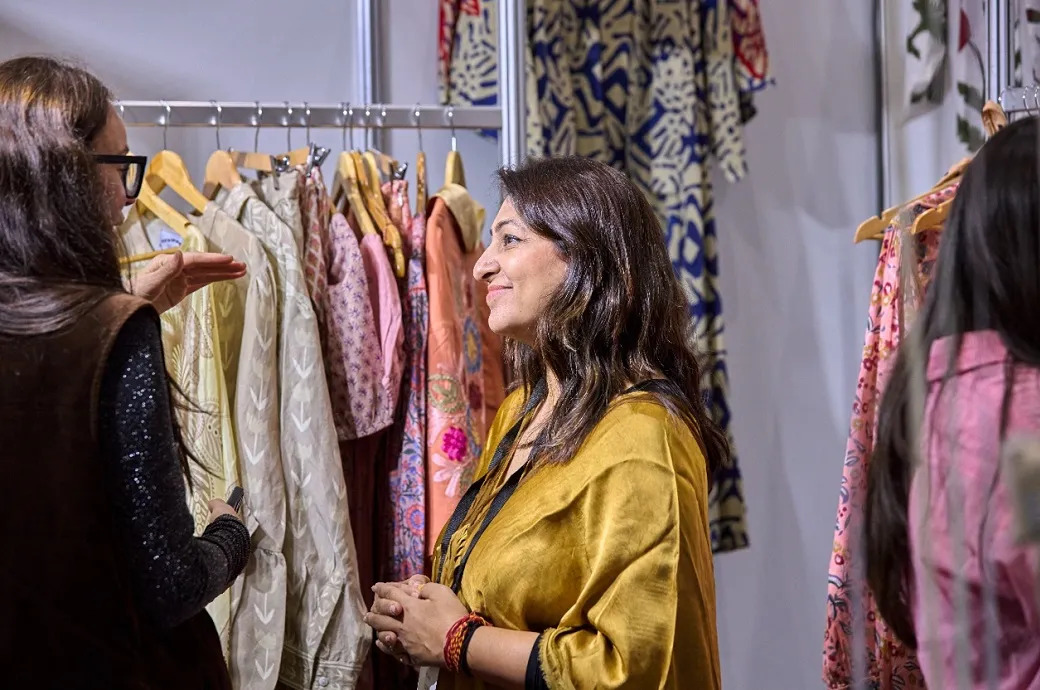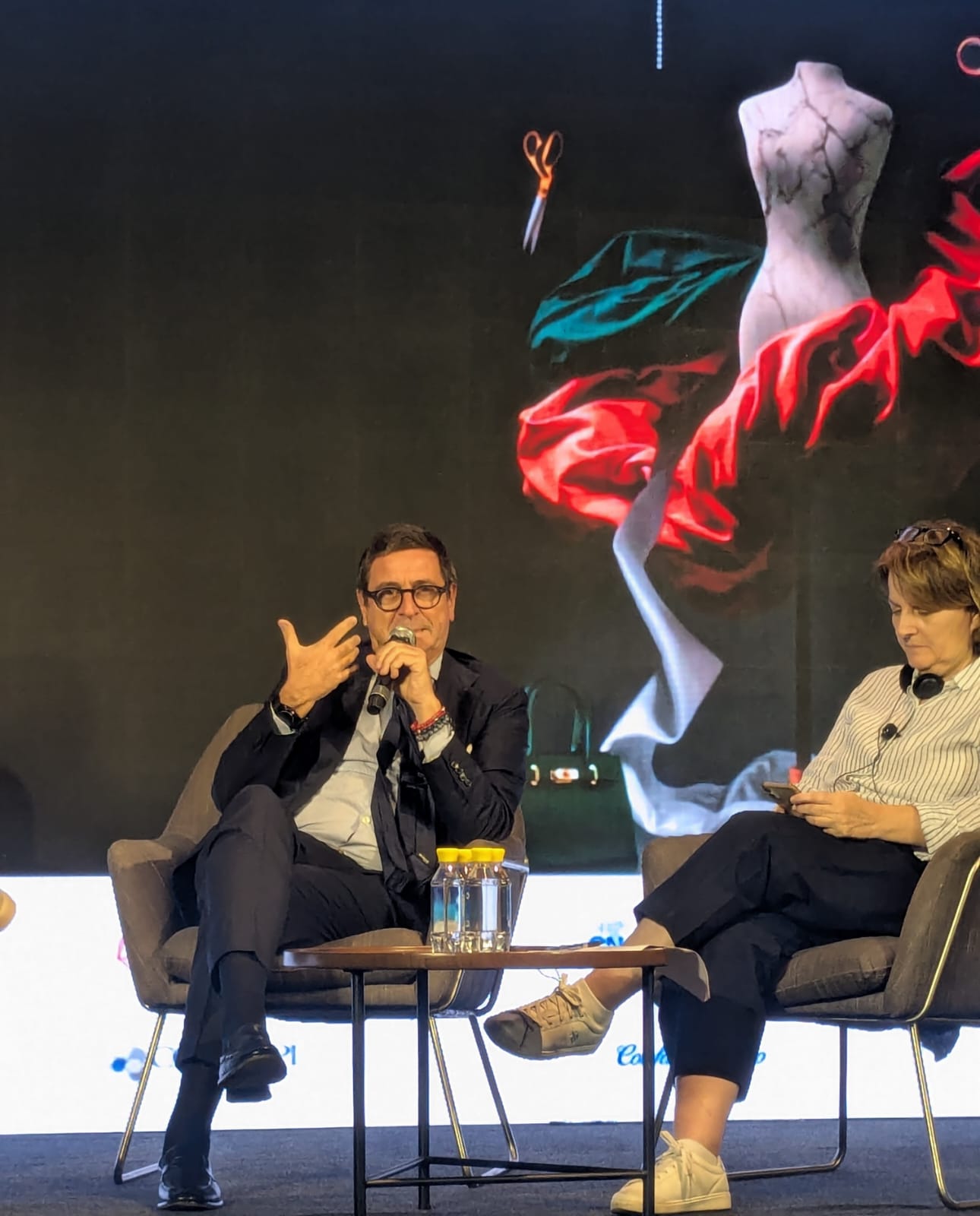FW
With concerns over Bangladesh’s garment sector growing, India is slowing emerging as a preferred apparel sourcing destination, says a recent report by the United States International Trade Commission (USITC).
A key factor for US buyers, India’s political stability makes it a reliable choice for brands to source high-value or fashion items from the country compared to other less stable countries, states the report. Brands have more confidence in India’s ability to manufacture and deliver products than in other countries, the report adds.
However, despite this, the Indian apparel market continues face certain challenges like high labor costs, small production units, and expensive logistics. Moreover, it hasa limited capacity to produce man-made fiber (MMF) garments, which restricts its growth potential.
Comparing India with other major garment exporters such as Bangladesh, Pakistan, Indonesia, and Cambodia, the report notes, along with Vietnam, these countries have steadily gained market share from China over the past decade. China’s share of US apparel imports declined from 37.7 per cent in 2013 to 21.3 per cent in 2023. During the same period, India’s share increased from 4 per cent to 5.8 per cent, with apparel exports to the U.S. reaching $4.6 billion last year. While the US remains India’s largest market for apparel exports, Vietnam has emerged as a major competitor, increasing its share from 10 per cent to 17.8 per cent
Hailing the USITC report’s recognition of India strengths, Mithileshwar Thakur, Secretary General, Apparel Export Promotion Council (AEPC), says, the report highlights India’s role as a specialist in high value-added products requiring high-skill levels and offering the highest degree of reliability.
The report also evaluates factors like supply chain reliability and product differentiation, instead of focusing solely on cost, he adds.
With one-third of India’s apparel exports headed to the U.S., India has solidified its position as the fourth-largest supplier to the American market. However, addressing challenges related to labor costs, production capacity, and MMF manufacturing will be crucial for sustaining and expanding this momentum.
Valued at $114.1 billion in 2023, the global plus size clothing market is projected to expand at a CAGR of 5.1 per cent from 2024-32 to reach a value of $178.2 billion by 2032.
As per a Global Insights Market report, this growth will be mostly driven by a cultural shift toward body positivity and inclusivity, which has gained considerable momentum.
Movements advocating for the acceptance of all body types have raised awareness and fostered a greater appreciation for diverse sizes. Statistics highlight, an average American woman wears larger sizes, emphasising the importance of inclusive fashion. As a result, advertising, television, and social media increasingly feature plus-size models and influencers, challenging traditional beauty standards and encouraging body acceptance.
The plus size clothing market is segmented on the basis of clothing type, with categories including casual wear, sportswear, formal wear, innerwear, etc. The market is dominated by casual wear, which having generated revenues of approximately $38 billion in 2023, is expected to grow at a 5.9 per cent CAGR over the coming years. The rising demand for fashionable plus-size casual wear is largely influenced by the body positivity movement, which has reshaped consumer perceptions of diverse body shapes and sizes. This has led to a substantial rise in demand for comfortable and stylish plus size clothing options.
In terms of materials, the plus size clothing market is divided into synthetic and natural fabrics. Accounting for around 64.3 per cent of total in 2023, the synthetic fabrics segment is expected to grow at a CAGR of 5.5 per cent during the forecast period. Synthetic fabrics are known for their durability, flexibility, and wrinkle resistance, making them ideal for plus size clothing, which requires materials that offer both comfort and shape retention. The fashion industry continues to evolve, with synthetic fabrics enabling the creation of modern designs that resonate with plus-size consumers.
Having led the plus size clothing market in 2023 with a 38.8 per cent share, North America is anticipated to grow at a CAGR of 4.5 per cent through 2032. The strong embrace of the body positivity movement has fueled the demand for stylish, comfortable plus size clothing in this market with further driving its growth. Additionally, the aging population in North America, which prioritises comfort without compromising style, contributes to the expanding plus-size apparel market in the country.
In contrast to last year’s struggles, textile and footwear enterprises in Vietnam are experiencing a rise in export orders, with many booked through the end of this year and even into the first quarter of 2025.
BạchHồng Long, Deputy General Director, No. 10 Garment Corporation, reveals, currently in the process of completing the orders received for 2024, his company has full orders until Feb’25, and is also negotiating new orders for Q1, FY25, with approximately 70 per cent of these already finalised. According to him, this is expected to boost the company’s revenue by 10-20 per cent in 2024 compared to the previous year. A shift in sourcing from other countries willhelp improve orders for 2025, he adds.
Similarly, with its order books full through 2024, Dony Garment Company is also negotiating for new orders through March 2025. PhạmVănViệt, General Director, ViệtThắng Jean Company, notes,his company has received transferred orders from countries like Bangladesh at lower prices. However, high-quality orders for European markets have not increased, as those markets are still in recovery.
TrươngVănCẩm, Deputy Chairman, Vietnam Textile and Apparel Association, explains, the current rise in orders can be attributed to a shift in sourcing from other countries to Vietnam, rather than an increase in global market demand. After the decline in US Federal Reserve interest rates in September and inflation rates in the US and EU, consumer spending for Vietnam’s textile exports in these key markets has picked up, he adds.
Cẩm further notes, external factors like natural disasters, political instability, and policy issues in other garment-exporting nations are also helping Vietnamese companies gain new orders. The peak year-end shopping season, driven by festivals and consumer discounts, is expected to further boost demand with lower freight costs helping garment exporters save on expenses.
As per Vietnam Textile and Apparel Association (VITAS), export turnover of the textile industryincreased by 9 per cent Y-o-Y to surpass $32.5 billion in the first nine months of 2024. With a rise in demand during Christmas and Lunar New Year, the sector is set to achieve its $44 billion export target for 2024.
A similar recovery is seen in the footwear industry, with exports reaching $20 billion in the past nine months. If the 10 per cent growth rate continues, the sector is projected to hit $27 billion in exports by the end of 2024. PhanThịThanhXuân, Deputy Chairman,Vietnam Leather, Footwear and Handbag Association, highlights, many footwear enterprises already have orders through the first quarter of 2025, and the industry is on track to meet its target.
Hosted by the Confederation of Indian Textile Industry (CITI) on Oct 21, 2024, the BharatTex 2025 - Bhilwara Roadshow was attended by over 100 key stakeholders from Rajasthan's textile value chain.
The roadshow was hosted in association with The Cotton Textiles Export Promotion Council (TEXPROCIL), Rajasthan Textile Mills Association (RTMA), and Mewar Chamber of Commerce & Industry (MCCI).
Shubhra, Trade Advisor, Ministry of Textiles, Government of India, was the Chief Guest at the roadshow. In her address, she reaffirmed the government's unwavering commitment to foster the textile industry’s growth, and emphasised on the importance of industry collaboration to make BharatTex2025 a landmark event.
Damodar Agarwal, Member of Parliament, Bhilwara, Rajasthan, who was also the Guest of Honor at the event, emphasised onBhilwara's crucial role in shaping India's textile future.
Rakesh
Mehra, Chairman, CITI, highlighted the unique opportunity presented by BharatTex 2025 to position India's textile industry on the global stage. He said, the event will not only showcase the strength of the Indian textile industry but also enhance its competitiveness on the global platform.
Dr Siddhartha Rajagopal, Executive Director, Texprocil, and Chandrima
Chatterjee, Secretary General, CITI, outlined the event's objectives to enhance India's textile exports and drive sustainable practices across the sector.
The event also hosted discussions between key industrialists and dignitaries addressing the critical challenges faced by the textile and apparel value chain in India.
The event concluded with a vote of thanks by Dinesh Nolkha, Vice Chairman, CITI & Managing Director, Nitin Spinners, who emphasized on the need for continued cooperation to elevate India's textile sector to new heights.
Driven by the gradual liquidation of retail inventories in key markets and a shift in global sourcing to India, revenues of Indian apparel exporters are expected to grow in the range of09 -11 per cent in FY25, as per a report by ratings agency ICRA.
This follows a subdued performance in FY24, when exports were hindered by high retail inventories, weak demand in major markets, supply chain disruptions, including the Red Sea crisis, and heightened competition from neighboring countries.
The long-term outlook for Indian apparel exports remains positive, supported by growing product acceptance in international markets, evolving consumer preferences, and government initiatives like the production-linked incentive (PLI) scheme and export incentives. The proposed free trade agreements with the UK and the EU are also expected to provide a significant boost, ICRA noted.
As demand recovers, ICRA expects capital expenditure (capex) in the apparel sector to increase in FY25 and FY26, with spending projected to stay between 05-08 per cent of turnover. Srikumar Krishnamurthy, Senior Vice President and Co-Group Head-Corporate Ratings, ICRA, explains, after a 2 per cent decline in FY24, Indian apparel exporters are likely to experience a 9-11 per cent revenue expansion in FY25. This growth will be fueled by replenishing retail inventories in key markets such as the US and the EU, along with a de-risking strategy adopted by many customers.
However, challenges remain, including demand uncertainty in several key markets amid a subdued global economic environment and ongoing geopolitical issues. Despite the anticipated revenue growth, operating margins are expected to contract by 30-50 basis points in FY25 due to rising labor, freight, and other operating costs.
Geopolitical tensions in Bangladesh may also lead to capacity expansions outside the country, potentially benefiting India. However, Bangladesh continues to hold a competitive edge due to its low labor costs and preferential duty access to the US and EU, which will remain for two more years under its least-developed country status.
ICRA highlights, India’s PLI scheme and the PM Mega Integrated Textile Region and Apparel scheme will strengthen the country's global presence by providing scale benefits and enhancing its position in the man-made fiber value chain. These initiatives are expected to help Indian apparel exporters capture a larger share of the global apparel trade.
Burberry has installed a new pavilion at Neiman Marcus NorthPark in Dallas. To run until Nov 10, 2024, the pavilion is inspired by the traditional park pavilions in the UK. It pays homage to Burberry's iconic outerwear heritage by offering visitors a unique, British-inspired experience.
The highlight of this pavilion is Burberry’s iconic trench coat, a symbol of British craftsmanship for over a century. Alongside this classic piece, the pavilion also features new designs including key outerwear styles for Winter 2024 such as parkas, puffers, aviator, and Harrington jacketsfrom Daniel Lee, Creative Director.
Additionally, the installation showcases a range of menswear and womenswear items from Burberry’s latest collection, with a focus on signature pieces like Burberry Check scarves, bags, and shoes.
A part of Burberry's broader global campaign, ‘It’s Always Burberry Weather,’the installation embraces the brand’s history of crafting outerwear designed to withstand ever-changing weather conditions. Named after a vintage Burberry slogan, the campaign celebrates the timeless relevance of Burberry’s outerwear and coincides with a series of pop-ups, window displays, and in-store activations worldwide.
The pavilion blends retail and entertainment to offer our clients a chance to discover Burberry’s rich outerwear heritage a captivating and memorable way, says Lana Todorovich, Chief Merchandising Officer, Neiman Marcus. The installation exemplifies the retailer’s ‘Retail-tainment” strategy, creating an extraordinary shopping experience for customers.
Kraig Biocraft Laboratories, Inc, a leader in spider silk-based fibers, announced plans for an investor web conference in the coming weeks. The Conference aims to provide a comprehensive overview of the Company’s achievements in commercializing its innovative spider silk technology over the past year.
As part of its commitment to transparency and engagement with shareholders, Kraig Labs will discuss recent advancements, production metrics, and strategies enhancing its market trajectory. Attendees can expect insights on total spider silk production, next-generation fiber development, targeted markets for early adoption, and production forecasts for 2024. These advancements are poised to significantly impact the global performance materials industry.
Kim Thompson, Founder and CEO of Kraig Labs, expressed excitement about the progress made in scaling spider silk production. He noted that the upcoming conference will highlight the company's advancements and demonstrate how they are implementing a commercially scalable spider silk system for textile markets.
Details for the conference are being finalized, and further announcements regarding the confirmed date and additional information will be released as the event approaches. This initiative reflects Kraig Labs ongoing efforts to engage with investors and promote its innovative technology.
Mohomed Bashir, the newly appointed President of the International Cotton Association (ICA), marks a significant milestone as the first Pakistani to lead the global body. Bashir, who also chairs Gul Ahmed Textile Mills, emphasized his commitment to fostering inclusivity, diversity, and collaboration within the cotton industry.
Bashir aims to enhance leadership representation and ensure every voice is heard, regardless of gender, culture, or industry segment. He sees his presidency as a platform to promote growth and equal opportunities, advocating for success based on merit and inclusivity.
Addressing the challenges faced by the cotton industrysuch as climate change, currency fluctuations, and evolving legislationBashir stressed the importance of uniting all supply chain sectors to find effective solutions. He called for increased participation from producers, retailers, and various regional sectors, highlighting the necessity of diverse perspectives in navigating industry complexities.
As President, Bashir seeks to protect stakeholders' interests and promote sustainable solutions. He encourages collaboration and innovation to tackle the industry's challenges and ensure a bright future for the global cotton community.
Bashir's extensive experience includes serving on various boards, including Gul Ahmed Energy, Habib Metropolitan Bank, and the International Textile Manufacturers Federation (ITMF). His contributions have earned him numerous accolades, including the Sitara-e-Imtiaz from Pakistan and the Knight of King, Northern Star Order from Sweden.
With a 23-member board, ICA continues to represent the global cotton supply chain, reinforcing its commitment to engaging the international cotton community.
Expotextil, Peru’s key trade fair for the textile and clothing sector, will be held in Lima from November 7 to 10, 2023. A delegation of Italian textile machinery manufacturers, organized by the Italian Trade Agency and ACIMIT, will participate, with 14 companies, including 11 ACIMIT members like Color Service, Danti, Dettin, and Santoni, among others.
Peru’s textile industry, a vital part of its economy, is a global leader in alpaca fiber production, accounting for over 80 per cent of global output. Cotton cultivation is also significant, particularly in northern Peru. In 2023, Peru’s textile and clothing exports reached $1.87 billion, reflecting a 19.6 per cent growth.
Marco Salvade, ACIMIT president, highlighted the importance of technological renewal for the Peruvian textile sector, emphasizing that Italian machinery offers efficient and resource-saving solutions. Peru, the second-largest South American market for Italian textile machinery, imported around €18 million worth of Italian equipment in 2023. In the first half of 2024, Italian sales reached €8 million, reinforcing the longstanding partnership between the two countries.
The Italian presence at Expotextil aims to further strengthen these business ties, helping Peruvian firms enhance production quality and remain competitive globally.
Operator of the Moss menswear chain, Moss Group’s revenue declined to £137.5 million during FY24 from £151.5 million in the previous year. The group’s EBITDA also declined to £25 million from nearly £36 million, while pre-tax profit halved to £16.6 million, and net profit lowered to £13.6 million from £26.7 million. The company attributed this decline in sales to a normalisation of wedding demand following a post-pandemic surge, which led to an overall sales decrease of 9.3 per cent.
Despite these challenges, Moss Group reported strong trading since the end of the financial year and expects this momentum to continue through January 2025. The company remains committed to providing high levels of service in its stores and has upgraded its online platform. It has also expanded its casualwear offering and rebranded its stores. To reflect a more modernised focus while honoring its heritage, the company has dropped the word, ‘Bros’from its name.
Acknowledging market uncertainties and rising costs, Moss Group maintained an 18.2 per cent EBITDA margin, describing it as a ‘creditable’ performance. The group remains debt-free and highly cash-generative, indicating strong financial resilience despite wider difficulties in UK retail. It believes its focus on offering high-quality products at reasonable prices positions it for future growth.
Looking ahead, Moss plans to optimise its store network by relocating five stores, refurbishing one, and opening three new locations. The company also plans to focus on cost control and product improvement to stay relevant in a competitive market. Besides, it aims to maintain a balance between its core formalwear offerings and an expanding casualwear range.












